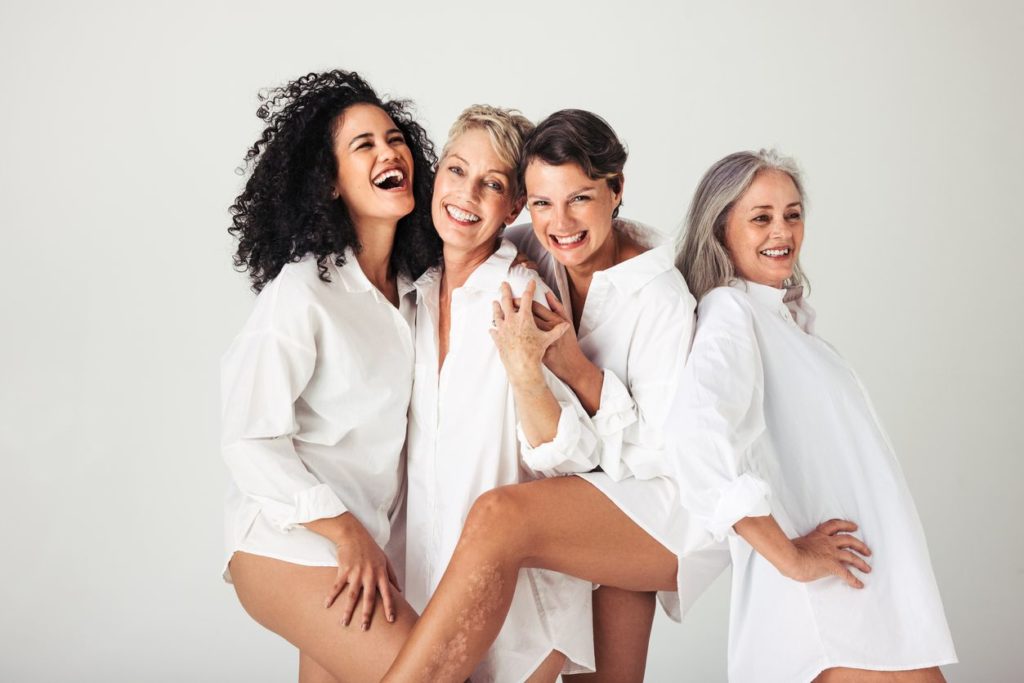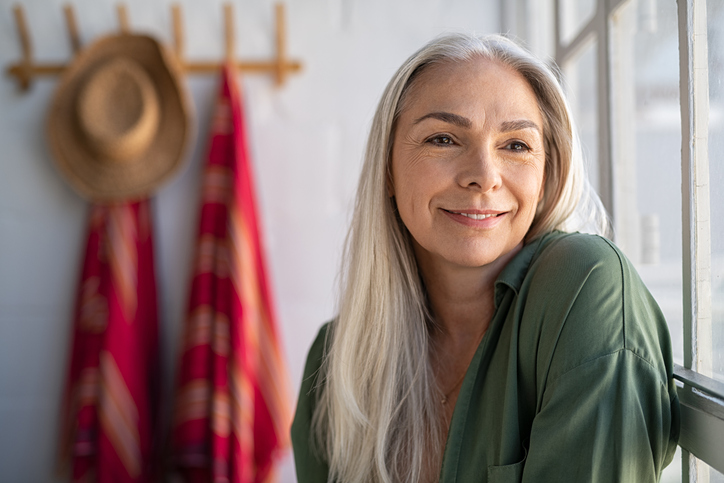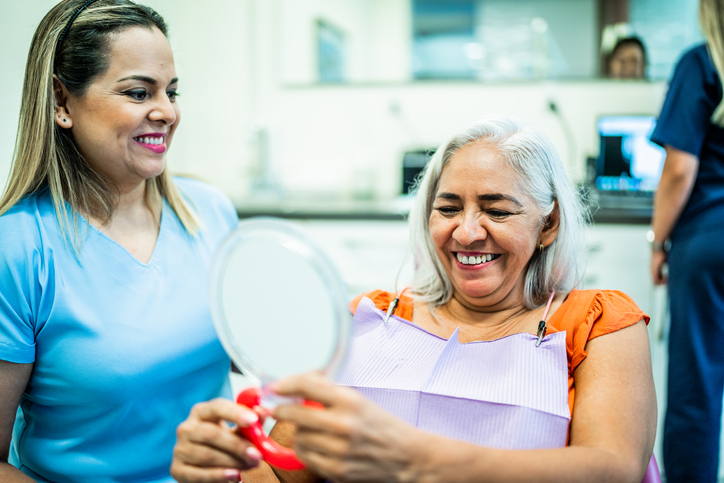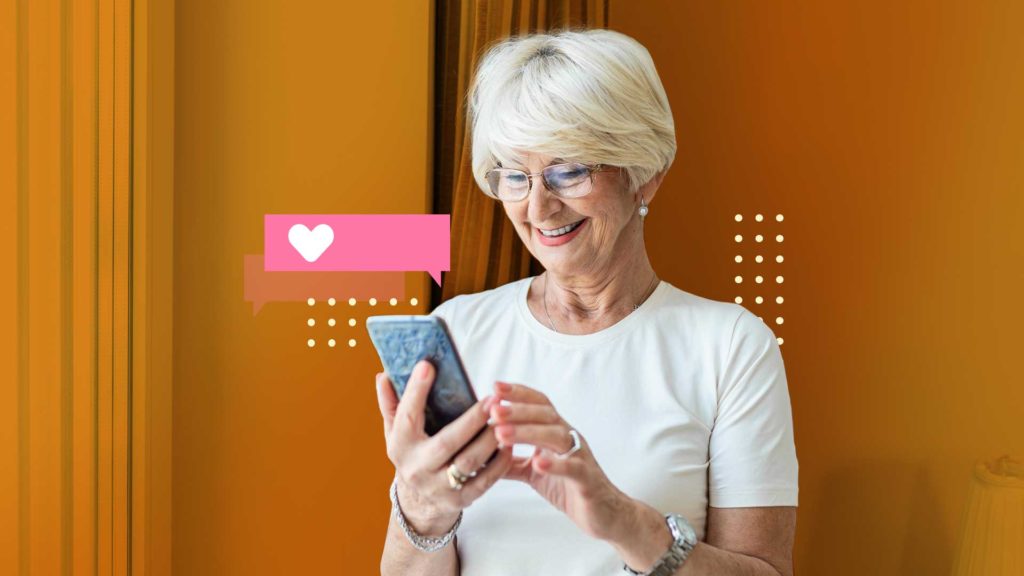
Embracing the Silver Revolution
The Rise of Anti-Ageism in Beauty
Updated on: September 2023

Over the past several years, the beauty industry has witnessed a paradigm shift in the ideals it champions. Gone are the days when age-defying remedies and gray-covering solutions dominated the market and the minds of consumers. Instead, there has been a palpable turn towards authenticity, as beauty standards evolve to be more inclusive and representative of the natural aging process.
The tide began to turn subtly at first, with a handful of celebrities and influencers proudly showcasing their gray strands or flaunting their age, defying the previously entrenched norms. This burgeoning trend soon gained momentum, leading to a broader societal acknowledgment and acceptance. Today, gray hair isn’t just accepted; it’s celebrated, worn as a badge of life’s experiences, and often even embraced by the younger generation as a stylish choice. This evolution signals not just a change in aesthetic preference, but a deeper societal transition towards valuing authenticity, experience, and the inherent beauty in the natural stages of life.
Find What You Need
Factors Fueling the Anti-Ageism Movement
What Factors Have Contributed to the Rising Trend of Anti-Ageism in the Beauty Industry?
The beauty industry, once dominated by ideals of perpetual youth, is now undergoing a seismic shift. One of the core reasons for this transformation is society’s growing emphasis on diversity and representation. No longer is beauty confined to a singular image; it’s now understood as a spectrum that embraces all ages, shapes, and colors. This realization has opened doors to a broader, more inclusive perspective where aging is seen not as a downfall but a natural, beautiful progression of life.
Moreover, today’s consumers are more educated and discerning. They question and challenge, seeking brands and products that align with their values. The demand for authenticity is higher than ever. Consumers are pushing brands to be transparent, and genuine, and to celebrate the natural aging process instead of disguising it. This dynamic shift in consumer attitude, combined with a more inclusive societal perspective, has paved the way for the rise of anti-ageism in the beauty sector.
How Have Fashion and Beauty Influencers Impacted the Acceptance of Natural Aging?
In today’s digital age, fashion and beauty influencers wield remarkable power in shaping perceptions and trends. They stand as role models, guiding the aesthetic preferences of their vast audiences. As more influencers embrace and celebrate their natural aging journey, it sends a profound message: Aging is not only natural but something to be proudly showcased.
Furthermore, influencers, by leveraging their platforms, have provided visibility to a once-marginalized demographic in the beauty domain: the older generation. Through their content, be it a gracefully graying hair tutorial or skincare that emphasizes radiant mature skin, they’re reshaping the narrative. This proactive stance by influential figures has significantly propelled the acceptance of natural aging, making it a celebrated and sought-after aesthetic.
What Role Does Social Media Play in Popularizing and Spreading the Acceptance of Gray Hair and Aging?
Outside of Hollywood, social media influencers, especially on platforms like Instagram, are actively pushing against ageist barriers. Figures like Francesca Leering (@silver.isthenew.black), Lyn Slater (@iconaccidental) and Grece Ghanem (@greceghanem) have garnered millions of followers, illustrating that style and beauty have no expiration date.
Social media platforms have been revolutionary in altering the global conversation about beauty and aging. Sites like Instagram, TikTok, and Facebook offer everyday individuals a platform to share their personal stories, triumphs, and challenges. This democratization of voice means that narratives around gray hair and natural aging are no longer dictated solely by beauty conglomerates; they’re crafted by real people with real experiences.
The virality factor of social media cannot be ignored either. A single post celebrating gray hair or mature skin can quickly garner millions of views, likes, and shares. These posts, in turn, inspire countless others to embrace and flaunt their natural beauty, creating a cascading effect. Through hashtags, challenges, and community building, social media acts as a potent tool, fostering acceptance and celebration of the aging process.
How Have Older Celebrities or Public Figures Contributed to the Normalization of Gray Hair and Natural Aging?
Celebrities and public figures, given their wide-reaching influence, play a pivotal role in shaping societal norms and perceptions. When older celebrities, who’ve spent the majority of their life under the spotlight, choose to embrace their natural aging process, it sends ripples across the global community. Their acceptance and celebration of gray hair or wrinkles act as an endorsement, signaling to the masses that these natural progressions are not just okay but beautiful and dignified.
Moreover, when celebrities resist the pressures of the entertainment industry to maintain a perennially youthful facade and instead showcase their mature beauty, it challenges long-standing industry norms. They serve as inspirations, reinforcing the idea that beauty isn’t confined to a particular age bracket. Their visibility on international platforms, be it film, television, or red-carpet events, ensures that these pro-aging messages reach and resonate with vast audiences, thereby driving the normalization of gray hair and the beauty of aging.
Are There Any Prominent Figures or Movements That Are at the Forefront of the Anti-Ageism Trend in Beauty?
Prominent figures championing the anti-ageism trend span a diverse range from celebrities, and influencers, to thought leaders. Celebrities such as Helen Mirren, Meryl Streep, and Jamie Lee Curtis have long embraced their natural aging, becoming iconic symbols of beauty without capitulation to ageist norms. The public embrace of their authentic selves serves as both inspiration and validation for countless individuals.
Additionally, movements such as the Silver Sisters – a collective of women embracing their natural gray – have fostered communities where individuals can share their transition stories, offering support and camaraderie. This intersection of grassroots movements with celebrity endorsements amplifies the message and reach of the anti-ageism ethos.
The Intersection of Body Positivity & Anti-Ageism
How Has the Movement of Body Positivity Intersected with Anti-Ageism?
Body positivity, a movement championing the acceptance and celebration of all body types, has naturally dovetailed with the anti-ageism trend. At their core, both movements seek to challenge and deconstruct society’s narrow definitions of beauty. Just as body positivity advocates for the acceptance of diverse body shapes and sizes, anti-ageism promotes the embrace of the natural aging process. Both movements stand united against societal pressures, pushing for a world where self-worth isn’t tied to appearance.
Moreover, as more people have rallied behind the body positivity banner, there’s been a collective realization: aging is an inseparable aspect of the human body’s journey. Thus, to truly champion body positivity, one must also embrace the lines, wrinkles, and gray strands that come with time. The amalgamation of these two movements has resulted in a more holistic and comprehensive perspective on beauty, where every stage of life, and every change that comes with it, is celebrated.
How Does the Acceptance of Gray Hair and Natural Aging Reflect Broader Societal Shifts in Values and Priorities?
The embrace of gray hair and natural aging is emblematic of more profound societal evolutions. In a world inundated with information and connectivity, there’s been a palpable move towards seeking authenticity. People are increasingly valuing real over curated, genuine over fabricated. This shift is evident in various sectors, from the farm-to-table movement in food to the rise of documentary-style content in entertainment.
Similarly, in the realm of beauty, there’s a growing appreciation for the authentic stories that lines, wrinkles, and gray hair narrate. They’re symbols of journeys lived, challenges overcome, and wisdom acquired. As society becomes more introspective, questioning consumerist pursuits and the incessant chase for perfection, the acceptance of the natural aging process serves as a testament to changed values. It underscores a collective understanding that beauty isn’t just about the present but is a celebration of the past and an anticipation of the future.
Beauty Industry’s Response & Evolution
How Does the Trend of Embracing Gray Hair Align with Sustainable and Eco-Friendly Beauty Practices?
The trend of embracing gray hair goes beyond just aesthetics; it also resonates with the global call for sustainability. Dyeing hair, especially to cover grays, requires a consistent application of chemicals, many of which may have environmentally harmful byproducts. By choosing to let gray hair shine naturally, individuals not only reduce chemical usage but also decrease the frequency of salon visits, resulting in reduced water consumption and lower energy usage.
Additionally, the beauty and skincare products associated with maintaining dyed hair often come in plastic packaging, contributing to the world’s plastic waste problem. The move towards embracing one’s natural gray reduces the demand for these products, aligning with the broader ethos of sustainable and eco-friendly beauty practices. Vegan skincare brand YukaFace embraces this in its anti-ageism ethos and earth-friendly approach. As the world becomes increasingly conscious of its ecological footprint, the trend of embracing gray hair stands as a testament to the symbiotic relationship between personal beauty choices and global sustainability.
How Are Skincare Routines Evolving to Focus More on the Health and Nourishment of Aging Skin Rather Than Simply Reversing Signs of Aging?
With the shift away from “anti-aging” narratives, skincare routines are evolving to emphasize the health, vitality, and nourishment of the skin. Brands are promoting products that prioritize hydration, barrier protection, and nutrition. There’s a growing emphasis on ingredients that support the skin’s natural functions, such as ceramides, hyaluronic acid, and peptides.
Moreover, there’s a move towards embracing natural, plant-based skincare products with ingredients known for their nourishing properties. Ingredients like green tea, rosehip oil, and chamomile, once relegated to niche “natural” brands, are now mainstream, reflecting a broader industry trend towards clean and sustainable beauty. Education is also playing a pivotal role. Brands are investing in educating consumers on the physiology of aging skin and how to care for it holistically. This focus on overall skin health underscores the industry’s shift from superficial beauty standards to a more comprehensive and inclusive understanding of beauty and well-being.
How Are Beauty Brands Adjusting Their Marketing to Cater to the Anti-Ageism Trend?
The pivot toward anti-ageism has prompted beauty brands to reevaluate their marketing strategies. First and foremost, there’s been a significant shift in language. Brands are phasing out terms like “anti-aging” in favor of more positive and empowering descriptors like “age-positive” or “pro-aging.” This change not only removes the negative connotations associated with aging but actively celebrates it.
Moreover, advertisements and campaigns are increasingly featuring a diverse age range of models, showing that beauty isn’t restricted to a particular life stage. By spotlighting older models, brands send a powerful message: Beauty evolves and matures, and there’s allure in every phase. Alongside this, storytelling is becoming paramount. Brands are emphasizing the narrative behind products, focusing on the journey of beauty rather than just the destination. This strategy not only resonates with older consumers but also fosters deeper brand loyalty by building emotional connections.
How Has the Representation of Older Individuals in Media and Advertising Changed Over the Years?
Historically, the representation of older individuals in media and advertising was limited, often restricted to stereotypical roles or backgrounds. When present, they were often portrayed in passive roles, reflecting societal perceptions of aging as a decline. However, as societal views shifted, so did media representation. Today, older individuals are portrayed in a spectrum of roles, from adventurers to entrepreneurs, challenging ageist stereotypes.
Furthermore, there’s a notable increase in the sheer volume of older faces in media. Whether it’s on magazine covers, fashion runways, or beauty campaigns, the mature visage is no longer an anomaly but a celebrated norm. This inclusivity not only mirrors societal shifts but also broadens the dialogue on beauty, ensuring that it’s multi-faceted and comprehensive.
Are There Any Negative Consequences to the Beauty Industry’s Previous Focus on “Anti-Aging” Products?
The beauty industry’s previous fixation on “anti-aging” came with its share of drawbacks. Primarily, it perpetuated a fear of aging, presenting it as a problem that needed fixing. This messaging had profound societal implications, leading many to believe that their value diminished as they aged, affecting self-esteem and mental well-being.
Additionally, the “anti-aging” narrative often oversold the capabilities of products, leading to unmet expectations and disillusionment among consumers. The aggressive marketing of these products sometimes overshadowed the importance of holistic skincare, emphasizing quick fixes over sustained routines. From a product formulation standpoint, the race to produce the next “miracle anti-aging solution” sometimes led to the inclusion of harsh ingredients, which could be detrimental in the long run.
Embracing Natural Aging: Pros and Challenges
What Are the Benefits of Embracing Gray Hair and the Natural Aging Process?
Embracing gray hair and the natural aging process has myriad benefits. At a practical level, it eliminates the consistent need for hair dyeing, thus saving time, and money, and reducing exposure to potentially harmful chemicals. Beyond the practical, it’s a step towards genuine self-acceptance, a proclamation that one’s worth isn’t tethered to societal expectations of beauty. It becomes a badge of life experiences, stories, and lessons learned.
Furthermore, letting nature take its course is environmentally friendlier. With fewer chemical treatments and products used, there’s a reduction in environmental pollutants and waste. This alignment with sustainable practices resonates with a growing segment of eco-conscious consumers, making the embrace of natural aging not just a personal choice, but a societal statement.
Are There Any Psychological Benefits Associated with Embracing the Natural Aging Process?
Absolutely. Embracing the natural aging process can be tremendously liberating. It fosters a sense of self-worth that isn’t predicated on appearance, promoting a more profound, intrinsic self-esteem. This acceptance acts as a shield against the pressures of ageist societal standards, often leading to increased contentment and happiness.
Moreover, accepting and celebrating one’s age can lead to reduced anxiety. The pressure to constantly ‘fight’ aging can be mentally exhausting, with individuals perennially chasing after treatments and products. Letting go of this chase can be mentally freeing, leading to a more peaceful and centered mental state. This mindset can also inspire others to embrace their true selves, creating a positive ripple effect in communities.
How Can Parents and Educators Teach the Younger Generation About the Value and Beauty of Aging?
Teaching the younger generation about the value and beauty of aging begins with representation. Parents and educators can introduce literature, films, and stories that present aging in a positive light, showcasing older individuals as protagonists with depth, wisdom, and relevance. Discussions around family trees, personal histories, and intergenerational experiences can also foster appreciation for the beauty of life’s phases.
Furthermore, educators can weave into curricula lessons on the biology of aging, demystifying it and highlighting its naturalness. Through art, history, and culture classes, the reverence many cultures hold for their elderly can be discussed. On a more personal level, facilitating interactions between younger individuals and their older counterparts — be it through mentorship programs, community services, or storytelling sessions — can build personal connections, making the value of aging tangible and real.
Are There Any Backlash or Criticisms Against the Anti-Ageism Trend in Beauty?
Like all movements, the anti-ageism trend in beauty has its critics. Some argue that it might inadvertently pressure individuals to embrace their grays or age-related changes even if they personally prefer treatments or products to maintain a younger appearance. There’s a risk of swapping one form of judgment (against aging) for another (against choosing to use age-defying products).
Others feel the movement can sometimes be co-opted by brands for profit, presenting themselves as “pro-aging” while subtly pushing products. This could dilute the genuine ethos of the movement, turning it into another marketing strategy rather than a genuine societal shift.
How Does Anti-Ageism in Beauty Impact Mental Health, Self-Esteem, and Body Image?
The anti-ageism movement in beauty has profound implications for mental health, self-esteem, and body image. At its heart, the movement seeks to decouple self-worth from age-defined beauty standards. As individuals embrace this mindset, there’s often a palpable boost in self-esteem. They no longer judge themselves by an ever-shifting, often unattainable beauty benchmark, leading to better mental well-being.
Moreover, by promoting a broader, more inclusive definition of beauty, the movement challenges and reduces societal prejudices. This can lead to better body image perceptions, as individuals no longer perceive aging signs as flaws but as natural and celebrated milestones. The ripple effect of this can impact society at large, leading to more inclusive, empathetic communities that prioritize well-being and authenticity over superficial standards.
Adaptation of the Haircare Sector & Stylists
How Are Haircare Products Evolving to Cater to the Specific Needs of Gray and Aging Hair?
As more individuals opt to embrace their gray and aging hair, the haircare industry has taken note and evolved its product offerings. Gray and aging hair have unique needs. The hair strands often become coarser, and more porous, and can sometimes have a yellowish tinge due to environmental factors. To address these, brands are formulating shampoos and conditioners specifically designed for gray hair. These products often include ingredients that brighten and neutralize yellow tones, ensuring the gray looks vibrant and radiant.
Furthermore, intense hydration and nourishing formulas are becoming staples. As the scalp’s oil production may decrease with age, maintaining moisture in the hair becomes paramount. Brands are integrating potent hydrating ingredients like hyaluronic acid and natural oils to ensure that aging hair remains soft, supple, and manageable. Additionally, strengthening components, such as biotin and keratin, are also being introduced, recognizing that aging hair may be prone to breakage.
How Are Salons and Hairstylists Adapted to the Increasing Number of Clients Who Want to Embrace Their Natural Gray Hair?
Salons and hairstylists have witnessed firsthand the surge in clients wishing to transition to their natural gray hair. Recognizing this trend, many have undergone specific training sessions focused on the unique challenges and opportunities presented by gray hair. Transitioning to gray, especially from previously dyed hair, can be a process that requires skill to ensure it looks natural and elegant.
Many salons now offer specialized transition packages. These might involve gradually lightening the dyed hair over multiple sessions, blending the dyed portions with the incoming gray, or even providing temporary color solutions that wash out over time, allowing for a seamless transition.
In addition to technical services, stylists are becoming counselors of sorts. Embracing natural gray hair is as much an emotional journey as it is a physical one. Recognizing this, stylists are often armed with advice, encouragement, and anecdotes to support clients through the transition. They provide invaluable guidance on at-home care, styling techniques, and product recommendations tailored for gray and aging hair.
Moreover, with gray hair becoming a fashion statement in its own right, salons are also offering innovative styling solutions. From silver highlights to graphite balayages, hairstylists are proving that gray hair can be as versatile and trendy as any other color, if not more. In essence, the haircare sector is not just passively adapting but actively celebrating the gray hair movement.
Broader Impact Beyond the Beauty Industry
How Are Younger Generations Reacting to and Supporting the Trend of Embracing Natural Aging and Gray Hair?
Younger generations, particularly Gen Z and younger millennials, are pivotal catalysts in the changing perspectives surrounding beauty norms. They are embracing diversity and championing authenticity at unprecedented levels, and this extends to the appreciation of natural aging and gray hair. For many, gray hair has even become a sought-after aesthetic, with some opting for silver or gray hair dyes, highlighting their commitment to dismantling traditional beauty standards.
Furthermore, younger individuals are leveraging their digital platforms, from TikTok to Instagram, to celebrate and normalize the beauty of natural aging. Whether it’s a teen proudly showcasing a premature gray strand or influencers interviewing their gracefully aging parents, these platforms echo with validation and appreciation of the aging process. This active celebration by younger generations provides a foundation for long-lasting change, potentially ensuring that the trend is not just fleeting but a genuine paradigm shift.
Which Industries or Sectors, Aside from Beauty, Are Being Influenced by the Anti-Ageism Movement?
The ripple effects of the anti-ageism movement are being felt in numerous sectors beyond beauty. In the fashion industry, there’s an increasing representation of older models on runways and in campaigns, signaling an appreciation for timeless elegance. Brands like Celine and Saint Laurent have featured older icons, showcasing that style knows no age.
The entertainment industry is also adapting. Movies and TV shows are casting older actors in central roles, not just relegated to stereotypical elderly parts but as nuanced, vibrant characters. The narratives are also evolving, focusing on the richness of experiences that come with age, thus providing a broader spectrum of stories.
In the corporate world, there’s a heightened awareness of the value of experience and wisdom. As conversations about diversity and inclusion gain momentum, age diversity is becoming a focal point. Companies are recognizing the pitfalls of ageism, leading to initiatives and training that promote intergenerational collaboration and respect.
Lastly, the wellness and fitness sectors are expanding their offerings to cater to older demographics, understanding that health and vitality aren’t the sole domains of the young. From yoga classes tailored for seniors to wellness retreats focusing on holistic aging, there’s a growing acknowledgment that age is just a number, and it’s how you feel and live that truly counts.
Looking Ahead
What Future Developments or Changes Might We Expect to See as the Trend of Embracing Gray Hair and Aging Continues to Grow?
As the trend of embracing gray hair and natural aging solidifies its foothold in mainstream culture, we can expect several developments. First, the beauty industry will likely introduce a wider array of products tailored to the needs of aging hair and skin, pushing the narrative from ‘anti-aging’ to ‘pro-aging’ or ‘age-embracing’. This might include ingredients that cater specifically to the nourishment, health, and vibrancy of mature skin and hair.
Further, as the media industry continues to adapt, we could see an even more significant increase in the representation of older individuals in diverse roles across television, movies, and advertisements. This shift will help in breaking down age-related stereotypes and showcasing a more authentic tapestry of human experiences.
In terms of societal values, embracing natural aging could further steer society towards valuing wisdom, experience, and the beauty of life’s various phases. It could also prompt a broader rethink of how we design our urban environments, from fashion hubs to recreational spaces, making them more inclusive of all age groups.
Lastly, on a grassroots level, we might witness more global movements and communities akin to the Silver Sisters, sprouting across various platforms. These collectives will continue to offer support, share experiences, and celebrate the journey of aging – ensuring that the message of anti-ageism doesn’t just remain a trend but evolves into a lasting cultural shift.
Final Thought
Over the years, beauty norms have played a pivotal role in shaping societal perceptions and individual self-worth. Historically, these norms have often been narrow, excluding a vast majority of the populace from the archetypal definitions of beauty. Breaking away from these traditional molds is not merely a fad or trend; it’s a necessary evolution that champions inclusivity, diversity, and authenticity. Recognizing beauty in its myriad forms, across all age groups, is a testament to society’s progression. It fosters an environment where each individual feels seen, valued, and celebrated for their uniqueness, rather than feeling pressured to fit into a pre-defined box.
Natural aging is a testament to life lived, experiences garnered, challenges faced, and triumphs celebrated. Instead of viewing aging as a decline, it’s vital to reframe it as a journey of growth, wisdom, and evolving beauty. Embracing gray hair, wrinkles, or any other sign of aging shouldn’t be seen as a defiance of beauty norms but rather an affirmation of one’s unique and ever-evolving beauty story. As society becomes more accepting, it’s crucial for individuals to internally celebrate their aging journey too. The narrative of beauty is vast and varied, and every chapter, especially those marked by time, deserves its moment in the spotlight. Encouragingly, as the winds of change continue to blow, the world seems poised to join in the applause for every shade, wrinkle, and silver strand.



